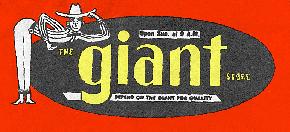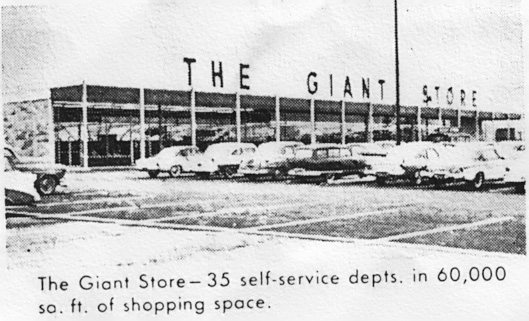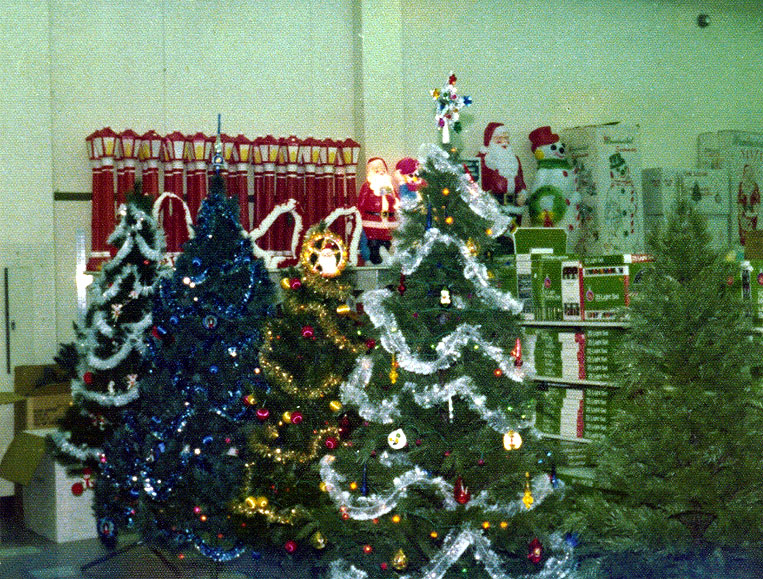AND NOW, MY SPECIAL SECTION DEVOTED TO...

�
AND NOW, MY SPECIAL SECTION DEVOTED TO...
|
�
 The Giant Store's South Bend, Indiana location.
The Giant Store's South Bend, Indiana location.
�
|
I didn't grow up with The Giant Store or even knew it existed until 1979 when I got my first look at their Cedar Rapids, Iowa location. But the Cedar Rapids store was singularly instrumental in fueling my renewed interest in older discount department stores, and that definitely merits a special section.
No, these aren't actual color pics of Cedar Rapids' Giant Store. They started out as shots of Jacks, its replacement, taken in 1981. But through the magic of Adobe Photodeluxe, they now look more or less as they did around 1979 when both The Giant Store and I were there.
|
�
|
The interior of The Giant Store in Cedar Rapids, Iowa as depicted in a 1964 newspaper photo. The accompanying article mentioned that one of the items on sale during its grand opening was a light airplane displayed in the parking lot, priced at $13,300. I wonder who bought it? |
�
|
It was fortunate for me that this particular Giant Store had outlasted many other smaller chains which had died out earlier in the 1970s (other Giant Store locations included Peoria and Rockford, Illinois, and South Bend, Indiana), and was still around after I got my first car and could drive it to Cedar Rapids and elsewhere. But in the fall of 1980 I went back there...and was devastated to discover that it had just recently closed and was being fashioned into something else. The old Giant Store signage was still up, including the great parking lot sign using the character pictured in the print logo (see above), which I'd once seen lit up at night in multicolored neon, but it would have to come down soon. I went home feeling far less optimistic than when I arrived in Cedar Rapids that same day.
|
�
 Enlarged shot of a vintage Giant Store price tag. This one was attached to a bag of peanuts.
Enlarged shot of a vintage Giant Store price tag. This one was attached to a bag of peanuts.
 "Why, certainly dear. It would be our pleasure to give your hair the same look as the illustration on the left in our Grand Opening ad. After all, we know you want to look nice for the premiere showing of "From Russia With Love". Why, just yesterday we did wonders for a young girl who told me she and a couple of friends had tickets to see The Beach Boys in concert."
"Why, certainly dear. It would be our pleasure to give your hair the same look as the illustration on the left in our Grand Opening ad. After all, we know you want to look nice for the premiere showing of "From Russia With Love". Why, just yesterday we did wonders for a young girl who told me she and a couple of friends had tickets to see The Beach Boys in concert."
�
|
In 1972 (I was off by ten years for some reason when I first added these pics; thanks to those who corrected me), the Chicago-based Jewel supermarket chain rolled out its own version of a combination grocery and department store called Jewel Grand Bazaar; the interior is pictured below. (Both photos courtesy of Mark Garast) |
�
|
|
�


Exterior and interior shots of Sioux City, Iowa's Bellas Hess Superstore the day before its Grand Opening on March 14, 1963. Note the nostalgic wavy canopy and repeating peaks on the roof outside. The store was described as being "as big as three football fields" and sold groceries and gas as well. How wonderful it was back then for a shopping emporium this massive to be greeted with equally massive enthusiasm and optimism, as opposed to today's endless "keep it out of our neighborhood!" protest rallys.
Eight of the following nine pictures were supplied to me by John Flack, who shares my interest in long-gone discount stores--thanks, John!
White Front was a popular West Coast chain; they had another discount division--Topps, pictured below--with several midwestern locations, one of which I had a chance to visit...once.
(above pic courtesy of Brett)
|
�
|
The New York-based E.J. Korvette chain was one of the first discount stores in existence, and one of the few to have made it through the 1970s...just barely. The older store pictured on top was in Lawrence, N.Y. |
�
|
Nichols Discount City, another New York-based chain, hung around a few years longer than did Korvette's... |
�
|
...and managed to keep a bit more of its 1960s ambience throughout, on the inside and outside of this Maple Shade, N.J. location. |
�
|
This Two Guys store in Marlton, N.J. was built in 1973, but the chain had other units going back to the 1960s. Also pictured here is a mock-up of one of their signs lit up at night, plus three of their old price sticker/newspaper ad logos from the early, middle and late 1960s (thanks to John Flack for supplying the last two ad logos and the sign pic!). |
�
|
The W.T. Grant department store chain had a discount division called Grant City. This is one such store in Clementon, N.J.; I had the letters colorized in Grant's familiar orange signage to make them stand out in the picture. |


Two 1973 interior shots of a Grant City store in Concord, New Hampshire, courtesy of Blair Bonds, who decorated the Christmas trees seen in the first shot.

(Picture courtesy of Bruce Montross, who also supplied the following information):
Barker's Department Stores was a part of a parent company called Franklin Stores Corp. In the 60s they were located in a very strange geographic area. They had stores in New York, Connecticut, Rhode Island, New Jersey and Pennsylvania as well as the Virgin Islands, Puerto Rico, Texas and New Orleans. They were the largest retailer in the Caribbean and one of the largest in New Orleans. They ranged in size from 40k sq. ft stores on the Texas-Mexico border to well over 100k sq. ft in New Orleans. Barkers was the purchaser of Kings Dept. Stores but changed the name of the Barkers stores to Kings. At that time they became the 7th largest discount dept. chain. Wal-Mart at that time was # 8. They shut down by 1982 and the remainder of the company not already shut down was acquired by Ames.
 Here is a typical parking lot Spartan sign with the word "discount" removed from the now-empty space just below "Spartan"; photos of the exterior and interior of the Cedar Rapids, Iowa store and its original manager appear below. When the store's name was changed to Spartan-Atlantic, the word "Atlantic" in red lettering replaced "Discount" on the sign and a similar sign was attached below the A, R and T on the building's sign.
Here is a typical parking lot Spartan sign with the word "discount" removed from the now-empty space just below "Spartan"; photos of the exterior and interior of the Cedar Rapids, Iowa store and its original manager appear below. When the store's name was changed to Spartan-Atlantic, the word "Atlantic" in red lettering replaced "Discount" on the sign and a similar sign was attached below the A, R and T on the building's sign.
(Immeasurable thanks to Dave Aldrich for the sign pic!)

I loved this store. It was a '60s classic through and through. It embodied all the elements that came to symbolize the 1960s discount store as I like to remember it, and memories of it today evoke nostalgia at its best. It had a wonderful, huge sign in the parking lot with the red "Spartan" letters on staggered white blocks and a red neon arrow pointing toward the store. One of its Kansas City locations was in Mission, Kansas, only a short distance away from the house we moved into in January, 1965, and I begged my mother to take me there after I got my first look at it from a distance as we passed by it on our way somewhere else. We finally paid our first visit to it that summer, and many visits soon followed.
The Mission store and another location or two were simply called Spartan from the beginning. Another discount chain called Atlantic Mills entered the Kansas City and Des Moines markets around 1961; these had their names changed later to Atlantic Thrift Centers. The D.M. unit remained simply Atlantic for its entire existence, but the K. C. locations (presumably) all became Spartan-Atlantic when the two chains merged. We still have at least two items purchased at the Mission store: a Fifth Edition "Jeopardy!" game from 1969 for around two bucks (we bought the First Edition there as well in 1965 and later wanted a newer edition with more up-to-date answers and questions), and an LP of Elton John's self-titled album with "Your Song" as the first cut. That was purchased in 1972, the year we later moved out of the state and back to Iowa. A year or two later, the Mission Spartan-Atlantic departed itself; coming and going in its place, respectively, were a gigantic flea market location, Toy City and Gold's Gym. Following the departure of Gold's Gym, the empty building remained standing for many years, as did a portion of the sign in the parking lot. Around 1999 or so, a small section of the building had been temporarily occupied by one of those seasonal "Santa's Surplus"-type businesses that spring up late in the year and then pull out in January. The red arrow was removed from the parking lot sign around this time as well. But I was dealt the most devastating blow in November of 2001 when, during yet another visit to the area, the building and the sign were razed and the site was being renovated to make room for something else. Another reminder of Kansas City retailing of yesteryear...gone forever. Happily, though, that "something else" wound up being Target Greatland, which opened in October of 2002. If the original Spartan-Atlantic building in that area had to fall instead of being preserved for another discount store to move into later, I can at least take comfort in the fact that the new building that replaced it on the same lot houses one of today's better surviving discount chains, as opposed to another ho-hum supermarket or office complex. Good for you, Target--you've filled a void in a small portion of Mission, Kansas that the unfortunate departure of Spartan-Atlantic created nearly 30 years earlier.
 Fate, however, was decidedly kinder to another ex-Spartan store in Oklahoma City (home of the first-ever location, opened in 1960). It was changed to a building supply store and, when I saw it during a visit to OKC in September of 2001, I was delighted to see that, outside of the necessary name change, the great old design from the Spartan days was mostly left intact.
Fate, however, was decidedly kinder to another ex-Spartan store in Oklahoma City (home of the first-ever location, opened in 1960). It was changed to a building supply store and, when I saw it during a visit to OKC in September of 2001, I was delighted to see that, outside of the necessary name change, the great old design from the Spartan days was mostly left intact.
The two faces of TG&Y. At top: one of their small "5¢ to $1.00" stores in Sun City, Arizona; below it is one of its "big brothers", a TG&Y Family Center in Lawrence, Kansas.


Headquartered in Oklahoma City, TG&Y was a prolific variety store chain with units in selected cities across the nation, though I never heard of them until I first noticed them in Kansas City in the mid-'60s, and I thought that was their "main turf". I was proven wrong in 1974 when they announced the opening of a Family Center in Indianola, Iowa; in fact they had a few of these in the Hawkeye State. The Family Centers were, of course, an outgrowth of the variety stores. And there was at least once instance where a TG&Y variety store actually grew into a Family Center; it happened to the unit at Fairway North Plaza in Fairway, Kansas arond 1968 or 1969. I remember the location and the transformation well, as I used to ride my bike to this location (those were the days...). There was also a TG&Y Variety Store located at Mission Mart on Johnson Drive which we used to frequent. It was one of their longer-lasting small units, having hung in there till the entire chain expired sometime in the late 1980s
TG&Y used to put their logo on everything from yarn skeins to cans of motor oil to portable radios and TVs, sometimes referring to them as "Golden T Products", and it was at the two nearest locales to our home that I got my first look at all of these new Ideal games: Watch Word (1966) and Cold Feet (1967) at the 5¢ to $1.00 Store, and many of their 1969 entries at the Family Center in Fairway.
Admittedly, TG&Y stores and signs were pretty nondescript, without the unique styling excesses that distinguished Spartan-Atlantic or The Giant Store (to name just two), but each Family Center seemed a bit different from another in terms of building design, which made their exteriors interesting to notice in one's travels across the region. Furthermore, TG&Y's desire to open actual Family Centers in occasional smaller communities (like the Indianola store) distinguished them much in the same manner that Wal-Mart would distinguish itself later. But when I first heard about the Indianola store going up, I was upset that they chose not to build one in another bedroom community near Des Moines--one that I was all-too-familiar with back then--and I insist to this day that had TG&Y built a Family Center there around 1968 or 1969, the town and its people would have benefitted from its presence. It sure would have beat yet another too-close-to-another supermarket on the same lot.
Several e-mails I've received over the summer of 2001 have necessitated a brief update here. First of all, to those who have asked me about the significance of the letters in the store name, they are merely the initials of the last names of its three founders--Thomlinson, Gosselin and Young. So far I only have Mr. Young's full name: Raymond A. Young. Another visitor to this site informed me that TG&Y, while not nearly as prominent or visible as it used to be, is still around today in a couple of Oklahoma malls, as well as a portion of Texas.
|
|
|
|
|
�